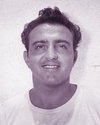George Barris
Famous movie cars

George's reputation was so big that he began working in top productions instantly after breaking through to Hollywood. The demand for his line of work was huge - kids loved cars and high-budget movies had increasingly more action scenes.
Building them wasn't the extent of the designer's job. He maintained them, arranged stunts, coordinated chase scenes, educated actors about how they should behave around cars to make their characters more realistic, and more. What people will remember him most for though were the iconic cars he has created.
The article tells the stories behind his most recognizable works, arranged chronologically as they were built.
Cinderfella / Golden Sahara
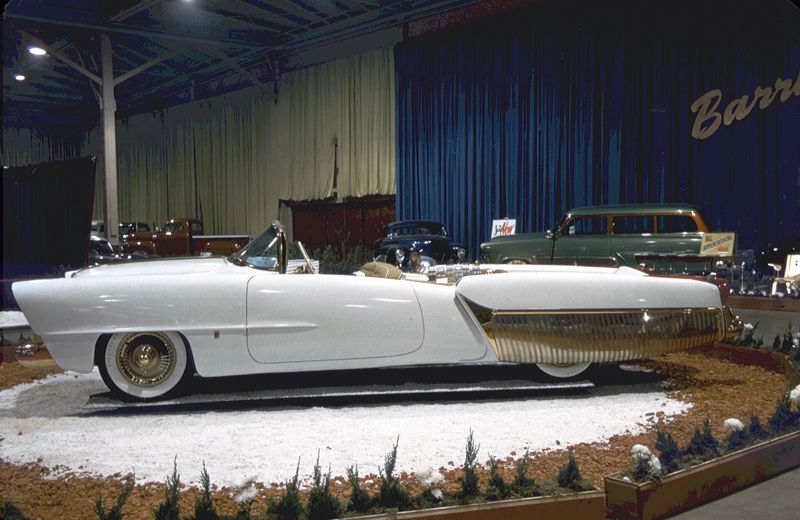
This poor Cinderella story adaptation, with Jerry Lewis goofing around the set armed with a bad sense of humor, was equipped with George's custom work. It is considered an absolute classic among car enthusiasts.
For Lewis' hansom cab (that substitutes his ordinary bike in times of glamour), Barris decided to use a custom car he had made earlier, named Golden Sahara. The machine was actually the second incarnation of a model based on 1953 Lincoln Capri. That one wouldn't be ever made if not for the accident which nearly costed the car nut his life.
It all started when Barris and his friend were on their way back from a car show. The long journey was spoiled when his companion's car broke down and had to be attached to his Lincoln Capri for the rest of the journey, or at least until they make it to someone that has the necessary parts to fix it.
To torment the two unlucky fellas further, a nearly impenetrable by the eye dense fog coated their path. The final blow was delivered by a hay truck that, coming out of nowhere, nearly swallowed the two cars.
Both Barris and his friend survived, but George's face was full of cuts and he needed doctor's attention. The problem was that they did not have a car to travel with, so they started wandering around on foot as soon as police got everything they wanted from them. After some time, the doctor was found. In a bar. Very drunk! George needed help though, so he crossed his fingers and let the man attend his wounds.
Lincoln's top was beyond repair and it had to be removed, together with some crashed body parts. This gave Barris an idea: what if he wouldn't just substitute it, but bring it back only partially and make a stylish construction instead?
That's how the Golden Sahara concept started. The name reflects the car's color palette.
The car was made for Jim Skonzakes, also known as Jim Street. Its estimated value at the time of release was $25.000. It came built with many luxuries, even now still associated with only the most expensive cars, like a refrigerator unit to power a small cocktail bar, remotely-opened doors, TV unit and tape recorder.
Skonzakes was another car enthusiast, albeit not as skilled in his craft as George was. He wasn't entirely happy with the result and decided to tweak it. To help bring it to reality, he engaged a skilled and creative team of specialists in Delphos Machine and Tool Shop (which exists to this day). In many regards, it was more reshaping than tweaking.
The end result was fantastic, and surely a visual upgrade of the original. On top of all the wonderful gadgets from the original version, it added many other wonders, like bubble top and first ever pearl paint on a car. It had numerous extra lights in interesting places (like the ones illuminating the tires) and golden elements all over the car. With all the glamour that it emanated with, the car also managed to completely avoid coming off cheesy and pretentious. Its estimated value was no joke either - $75.000.
Golden Sahara II was Jim's life achievement and he was naturally very proud of it, exposing it to as big an audience as possible on car shows, exhibitions etc. Some sources claim that he sometimes kept the remote in his sleeve and pressed buttons secretly while giving verbal commands, so the audience thinks that it's his voice that's responsible for various automated things the car did. One way or the other, it was pure science-fiction at the time.
That second incarnation has been immortalized in Cinderfella - a movie whose quality leaves much to be desired, but at least this way our generations can appreciate its beauty on film.
The second time it was filmed was two years later and it was for the CBS panel show I've Got a Secret. Jim is present in this movie and makes quite an impression by presenting what this piece of work comes equipped with!
The Munsters / Munster Koach
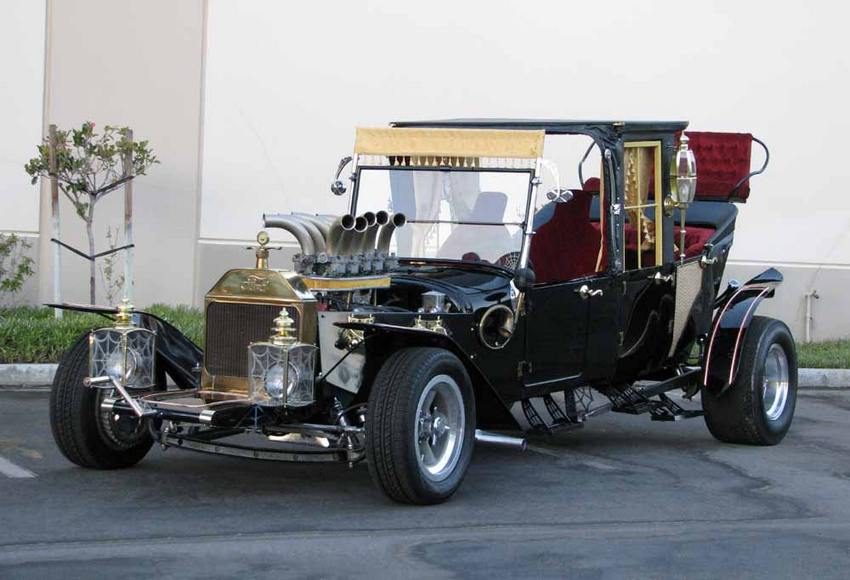
In 1964, another order came Barris' way when a new sitcom called The Munsters was coming into shape.
The show was practically a twin sister of another franchise popular to this day - The Addams Family, telling a monster family story centered around humorous mishaps. The former was airing on CBS and the latter on ABC. First episodes of each were released 8 days apart from each other.
Both producers of The Munsters were big fans of George's customized cars, but it was a man working for the studio that got Barris into it. He called him one day, saying that there is this show that's being made right now that has an awful-looking hearse as its car mascot, and asked if perhaps he'd like to chip in. Set up for a meeting with the producers, Barris offered his services despite tight schedule.
Tom Daniel was assigned with designing it, but many people had their say. For the task, he bought three Model T Fords (known for being the first cars affordable to the consumer masses), cut the parts not needed and made a centipede out of the rest.
The resulting monstrosity ended up five-and-a-half meters long (18 feet). For that bulky thing to move, a hefty engine needed to be installed. The Kustoms team decided on AC Cobra's V8 engine, also engineered by Ford. Show's character had to be taken into consideration too, so every row of seats was planned to contain elements and gadgets signalling whose place was it.
Building it was a gruesome task, because George's team of skilled maestros only had three weeks to do it. This resulted in them working their butts off for entire days, sometimes even napping on the spot, as every second was precious. Every participant was extremely tasked after those three weeks, but they made it in time.
The price George negotiated for the work was $18,000, which today would be something close to $140,000.
Finally, the car was named Munster Koach. There is no information about who named it, but given the capital 'K' up front, it is fair to assume that Barris was responsible.
The Munsters didn't become a big success, but it attracted a loyal fanbase, and of those many were in love with the car. It practically became the hallmark of the series.
Because of how big its impact was, soon request came to make another. In the episode Hot Rod Herman, the Fred Gwynne character loses the Munster Koach in a race, so Grandpa builds one to win it back in another race. He names it The Dragula - a reference to Dracula, which Grandpa was modelled on just as much as Herman Munster was modelled on Frankenstein.
The real vehicle was created by the same crew, with both Barris being the mastermind and Tom Daniel being the designer. This car was more minimalistic, but also more offbeat.
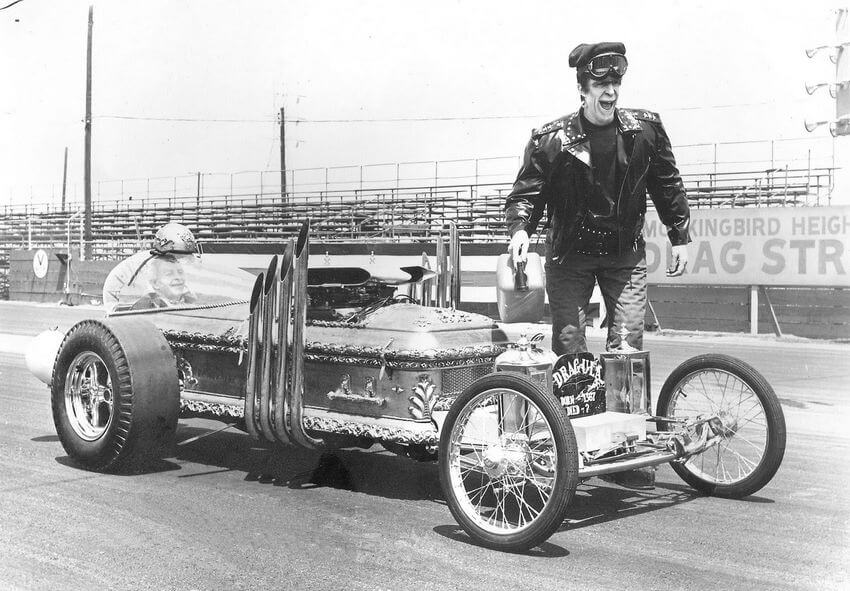
The coffin, which hid both the car's engine and the passenger seat, was the real thing and had an interesting story behind it. Looking to buy one, Barris wandered around Los Angeles funeral homes, but was brushed off every time. No body, no casket!
Finally, he and his few pals entered a North Hollywood funeral home where the employee was more lenient. George noticed a casket with a crack, took the man to the side and silently gave him money while his friends even more silently took the casket without waiting for the signal that the deal is done.
The vehicle wasn't just for show and had to function, so anything breaking could force mechanics on the spot to work under great pressure - every second would mean studios bleeding money. Thinking in advance, Barris offered the producers four more models, so they can swap them at will if anything goes south. This way, he would make more money and they would save some too. The Munsters team agreed.
Batman / Batmobile
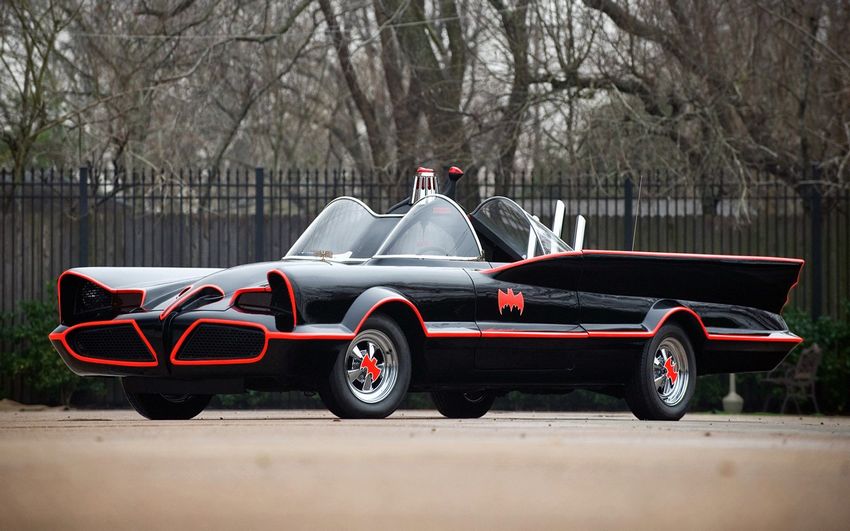
Following soon was Barris' opus magnum, the one car that would instantly come to mind when hearing his name. It wasn't his prettiest creation, most complicated or expensive to make, but definitely the most popular and easily recognizable by the masses to this day.
It was built on Lincoln Futura, a very wild and exotic prototype that was supposed to be as futuristic as possible, as the name implies, only to now look like a 1960s' underwater toaster on wheels.
A super-expensive product costing approximately $250,000, it became an instant hit at shows, but not much more than that, with only some parts being implemented in future Fords. Futura as a whole was yet another concept car destined to be forgotten. Or so it would seem.
Folks at Ford had great admiration for Barris' work and he often based his designs or borrowed concepts from the brand. As he was part of Ford Custom Car Caravan (see sidenote) they sold it to him... for a symbolic $1, which must have crushed George financially.
He wasn't interested in working with the Futura, nor was there any assignment where it would be a good choice, so it was just gathering dust on his property just as it would in one of Ford's garages.
In 1965, the Batman TV show was shaping up. These days mostly appreciated for its ever-present cheesiness and an abundance of crazy dialogues used in many hip-hop and turntablist records, it was a big deal at the time, and with a car budget to match.
The show producers contacted Dean Jeffries (another custom car legend that made his way to Hollywood) and offered $30,000 for designing Batman's vehicle. Jeffries was very happy about it, except for one thing - they wanted it done in three weeks and he said that it's impossible to finish the project on such a short notice. The producers didn't have more time, so the deal wasn't struck.
Barris and his team were not only known for quality of their products, but also for working under pressure, which they had proven two years earlier by delivering for The Munsters (also in three weeks). George was soon offered the same terms and he accepted.
This time, he went outside of his firm to gather a talent pool capable of delivering on such a short notice. Eddie Graves, a production artist on the 20th Century Fox payroll drew sketches that the project had to bring to life. Herb Grasse, the designer of the classic Bricklin SV-1 made a substantial input. Another famous name was Bill Cushenberry, who built the bubbly car he named (The Silhouette. Bill did the metal shaping.
One insider worth mentioning was Richard Korkes, whom Barris enlisted into his crew after his 1962 Jaguar job he did for Bobby Freedman and few other successful projects.
The team replaced Futura's 368 cubic inch engine with a V8 427 one, extended the car's fins, removed the middle part of the bubbly windows, the whole front was shaped so that it resembles a Batman face, wheel wells were opened. Many gadgets like Bat-phone, Bat-light, radar and hydraulic cable cutter were designed and given by the producers for Barris' team to install.
The car ended up such a success that soon Barris patented his design and 20th Century Fox insured Batman's ride for $125,000.
Already skilled in utilizing show's assets for marketing, the studio requested four additional cars that were used for various promotional events. These replicas weren't identical, there were differences both in looks and in what was under the hood.
The show's crew was eagerly anticipating the moment the Batmobile gets delivered, but the first surprise related to it they did not enjoy. Wanting to start shooting as soon as possible, they drove it into the Batcave, as the scene started with the automobile going out of it. They needed to get some tires first though, so they borrowed very expensive racing ones.
As it turned out, while making his first turn inside the car, the stunt driver popped a tire! The filming has barely begun and they were $1,000 short already (each tire costed that much).
This was just the beginning of problems for the crew. The engine was overheating and the shield had a blurry spot which made it harder to navigate. Because the car was exploited heavily for the show, various malfunctions accumulated with time, which the cast had to deal with carefully.
Alarmed by the increasing amount of mishaps, the studio paid Barris to do what's necessary to make it functional and safe. As a result, many parts were replaced completely.
After keeping the original Batmobile safe in his garage, Barris decided to put it on auction. On January 19, 2013, Barrett-Jackson Scottsdale Auction held a sell-off. A man called Rick Champagne came away a happy camper, winning a hard-fought bidding war. The final price was $4.2 million and on top of that, Champagne had to pay 10% more to cover various extra costs.
Mannix
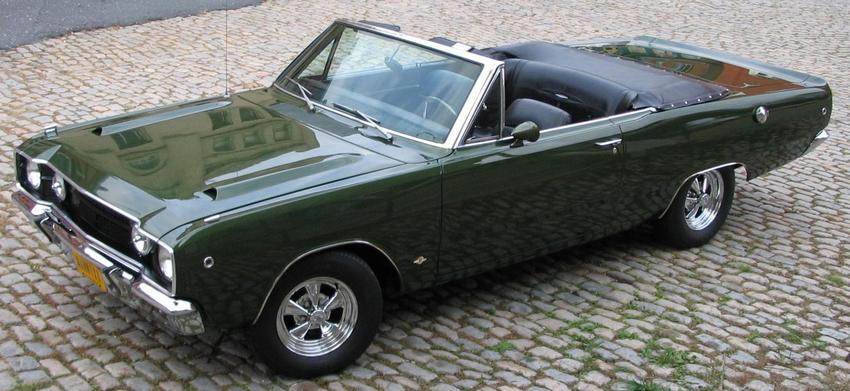
Mannix was a detective show, and since detectives have to drive across town to gather evidence, follow the suspect discreetly or straight out chase him (and Mannix did all those things), Joe Mannix needed his car.
He ended up having many, but most common were two models, each appearing in a single series.
The first one was a reworked Oldsmobile Toronado (first U.S. front-wheel drive car in quite a while). Producers wanted a convertible, so the roof had to go. Most critical parts were beefed up considerably, too.
Two versions of the car were made. They looked identical, but one was tailored towards stunt work, while the other was for presentations. This way, if one did get banged up and the next scene required a revealing close up, its delicately-treated brother was ready to shine.
Series 2 introduced a treated 1968 Dodge Dart GTS 340. Here, it was a very minimalist redux, which suggested a low budget, especially that the car itself wasn't pricey and neither it was particularly appreciated for its looks by the masses. One thing kustomized version of the car had going for it was a built-in phone. As opposed to the earlier George TV series creations, this one was fully-functional.
American Graffiti
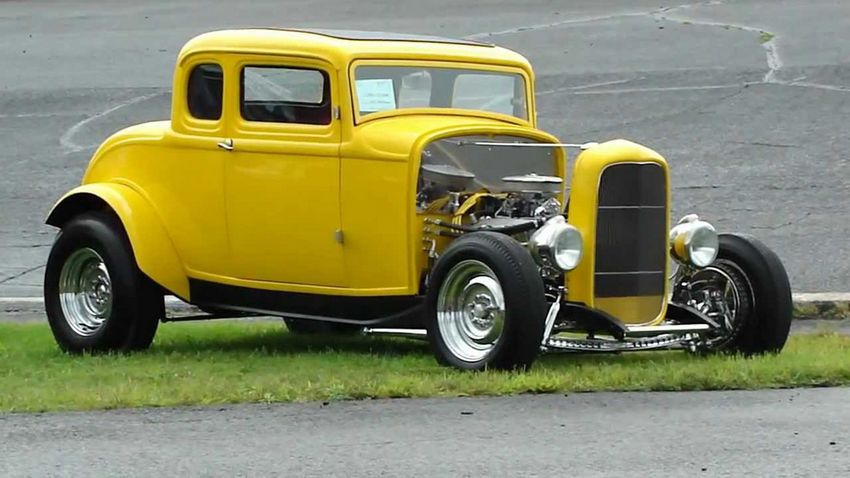
American Graffiti provided a completely different kind of challenge than the ones Barris was used to, but that kind he would probably love to do every day for the rest of his life.
George Lucas' debut seemed like a flop at first. Universal had a lot of faith in the young director who would soon break the system with his Star Wars franchise, but when the execs saw Lucas' finished debut, they wondered if it is worth releasing it at all. The potential loss wouldn't be that great, as despite that faith, not much much budget was granted for this film.
George Barris didn't feel the heavy producer's breath on his neck, as the resources were allocated in his favor. American Graffiti was about having fun as teenagers, racing friends in fast cars, picking up girls, showing off and acting irresponsibly. Cars were the vital element of the story and there's probably more scenes involving cars than not.
As opposed to his usual take-a-car-and-arm-it gigs, this time he wasn't doing any modifying, but instead was responsible for manually selecting and importing 300 different cars.
The movie was a cultural footprint, it was supposed to capture being a teenager in that specific culture at that specific time. Everything had to be as realistic as possible, otherwise everything would collapse like a house of cards.
George was hired for that realism. The cars in this film had to be the cars 1973s kids were really in love with. What other person would know more about dream cars than the guy who is making them?
All that being said, main 'car credits' have to go to George Lucas himself. Just like Barris, he also spent his youth chasing girls in polished cars and even did some racing. By himself, he knew perfectly what he was doing, but since he was the director responsible for so many things, presence of a guy like George Barris was necessary.
During the shooting, he could pretty much relax though. Due to low budget, everything had to be done in 29 days only. Within that timeframe, he was only responsible for staging the race.
Sleeper
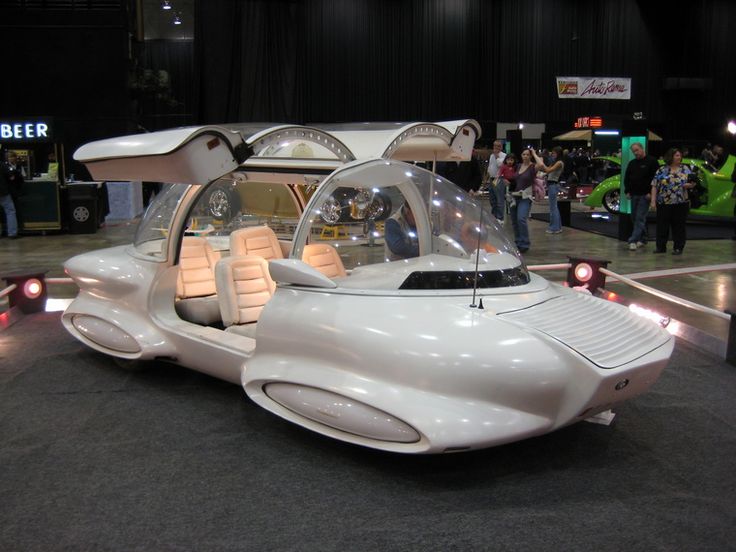
Same year as American Graffiti, Barris contributed to another Hollywood production more ambitious than what the designer was used to. It was Woody Allen's Sleeper, a movie about an average man leading a fight against totalitarian government after waking up from a 200-year long cryopreservation he had not signed up for.
Science-fiction setting, coupled with a thin budget, put Barris out of his comfort zone once again. He had to use his imagination to design something that looks extremely futuristic, while at the same time is cheap and easy to build.
Gone in 60 Seconds
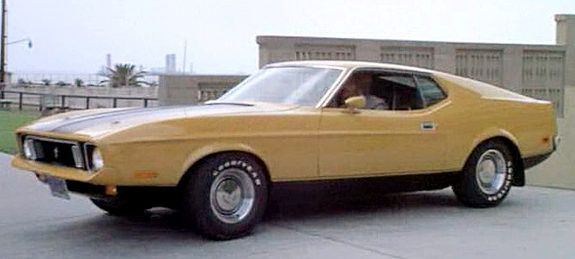
Gone in 60 Seconds was similar to American Graffiti in that it centered around fast and exciting cars. But instead of being an expression of youthful vigor, enthusiasm and rebellion, in this film the vehicles are first pricey items to be stolen, and then the tools used to escape the police.
It was a typical movie for Barris, he had done many of those before. Centered around car action, the story was neglected in favor of driving scenes (which in the end worked against it). Those were the fire-and-forget kinds of movies, and towards those George gravitated naturally. They gave him the space to do what he does best and enjoys the most.
The movie ended up extremely costly for Henry Blight Halicki, who wanted it to be his life's greatest achievement. He directed it, starred in it, produced it and wrote a script for it. Armed with people like George Barris, who was responsible for stunt coordination in chase scenes, he was really pushing for maximum effect.
Always in the heat of things, he encountered many close calls during the filming. Once, he crushed into a telephone pole and had to be hospitalized, and in the film's final scene he performed a grand stunt - a 39-meter-long (128 feet), which damaged his spine and made him limp from then on.
Fifteen years later, while making the second part of the movie, Halicki had another close encounter with a telephone pole. This one costed him his life. The movie never saw the light of day.
The Car
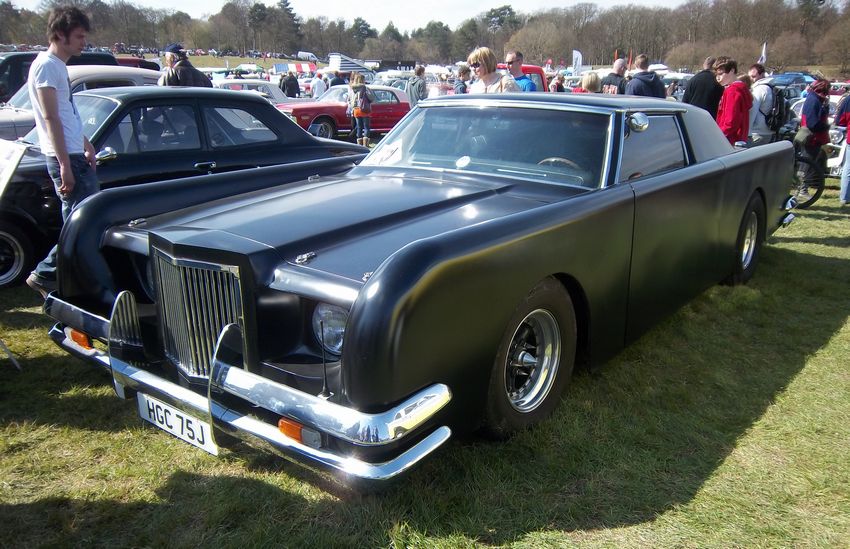
The year 1977 saw Barris contributing to a movie with title he just couldn't pass up - The Car.
Same year as the designer's another input in The Van (guess who did the title van), this one told a story clearly inspired by Steven Spielberg's debut Duel. The devil takes the shape of a mysterious black car that terrorizes (and preferably kills) peaceful villagers.
James Brolin played a main part in that one, but that didn't save the flick. As opposed to Duel's track driver nut stalking, which could happen in real life, here bikers don't know any better than just drive straight until they die, dozens of people get herded into defensive positions and not a single person thinks of picking up a rock, nor firing a gun (which there are plenty in the USA).
But again, why would Barris worry about such details? The money was coming in and he was to design a vehicle, which will even find its way onto the front cover and movie posters.
As the car was playing a central role in this movie, it was well-financed. As much as $84,000 was put aside to make a vehicle capable of taking abuse. And it was expected to take a lot of - additional models were built just to get smashed and crashed.
The 1971 Lincoln Continental Mark III served as the base. The top was chopped and redone, the grill hand-made, full body roll bars were installed as well as a powerful V8 engine. To give the machine a menacing look, 20 coats of black pearl paint were put on and black car windows were installed.
One thing that instantly comes to mind when looking at the car is how massive it is. The body is brick-shaped and terrorizing, which is even more accentuated by the top, with small windows standing in sharp contrast (and revealing the least of the mysterious driver's identity).
While it is not the first car designed this way, it certainly must have been an inspiration for designers of similarly-looking automobiles decades later, like Chrysler 300 (which also excelled at scaring bystanders).
Knight Rider / Super-Pursuit KITT, convertible KITT
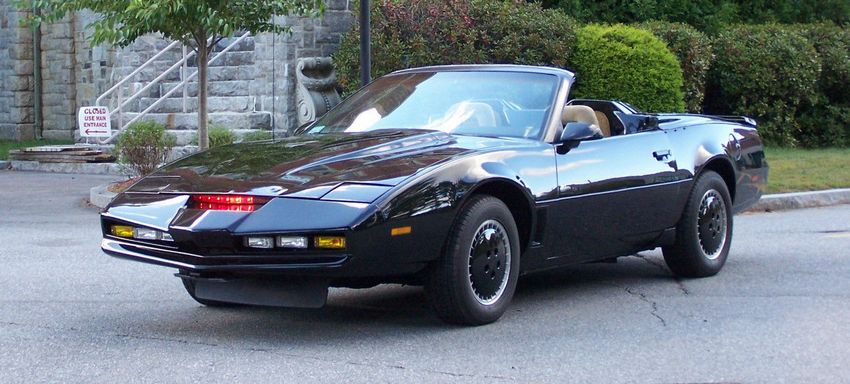
For Knight Rider, Michael Scheffe was hired to deliver a vehicle. He modified a Pontiac Firebird Trans Am into what is one of the most recognizable cars in modern TV history.
Named KITT, the intelligent and eloquent vehicle was designed to compliment the main character. Bringing machine into the human role was the bull's eye. The audience loved it!
Given that it was exactly the type of gig that Barris loved, it was probably hard for him to swallow the fact that this one didn't come his way, but he managed to make his presence felt in the series later.
George was hired for the last, fourth episode of the series, which introduced two new KITT modes: Super-Pursuit KITT and convertible KITT. Both were designed by the hot rod fanatic. On top of that, he helped address many issues that were troubling the producers.
They were bleeding money heavily by crushing KITT after KITT. Little did the audience know that their beloved vehicle had died many times under horrible circumstances just so they can enjoy the show!
Barris replaced some Pontiac parts to make the stunts safer and for the poor cars to live longer, and helped arranging stunts better.
Jurassic Park
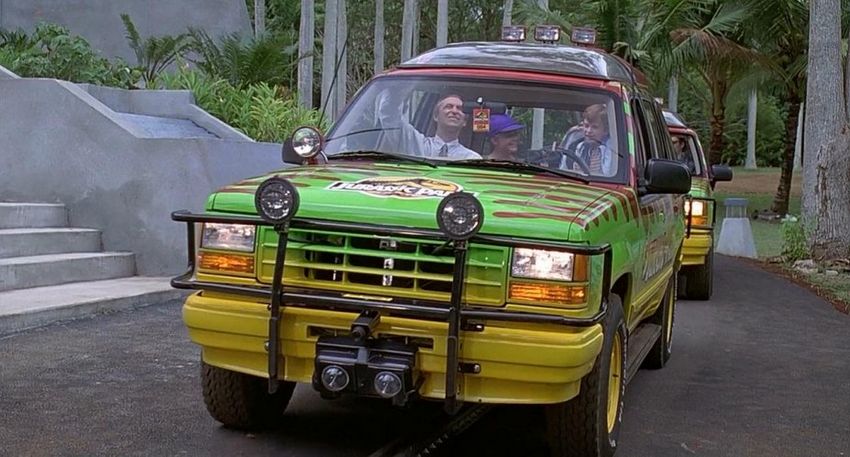
While Spielberg was in the process of making one of his finest movies - Jurassic Park, film producers contacted George Barris to deliver two types of machines.
The first type were tracked cars that were the driverless sightseeing boxes in the park. In the 39th minute of the movie, Richard Attenborough (David Attenborough's brother) doesn't hide his excitement about those, saying "Aren't they lovely? Aren't they glorious? (...) Top of the line. Spared no expense!". In reality though, those were humble first generation Ford Explorer SUVs.
One most obvious modification were the glass roofs covering two-thirds of the roof area and numerous additional lights. The paint was playful and kid-friendly, adding to the nice family reunion atmosphere soon to be shattered by vile creatures who would rather paint them red.
Cruising through the set were also five 1992 Jeep Wrangler Saharas. These were used by the park employees for their daily chores. There were five of them, each one had a different number on its left side. The numbers used were: 10, 12, 14, 18, 29.
Already way past being aware of the marketing value of customized vehicles used in the movies and even making a lot of money by selling them later to rich collectors, big studios now guarded their prized possessions and designers like Barris couldn't just drive them home after all the work was done. Jurassic Park is the best example of that new reality - of the many cars made for the movie, neither has found its way into George's garage.
The Flintstones
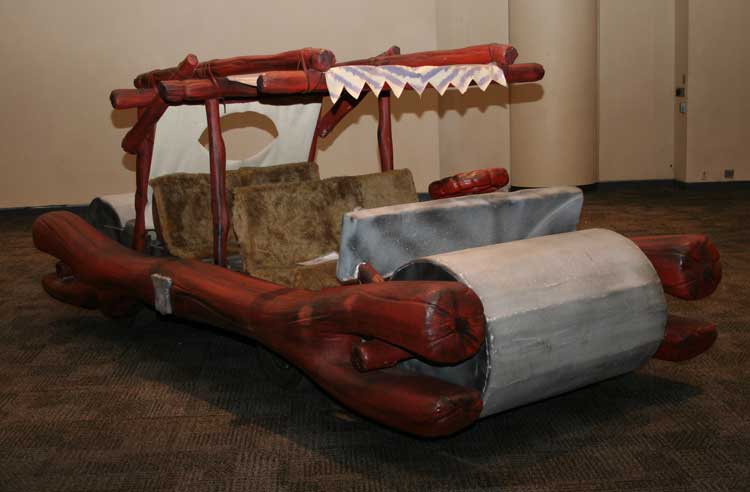
Barris again stepped out of his comfort zone (and frankly, his competences too) in 1993, when he accepted the gig at Universal. He was to design a car for the movie The Flintstones.
The vehicle is an iconic part of the series, to the point that it got included on the front cover, so the job had to be done with all kinds of considerations in mind. It is strange that folks at Universal decided to call George, not known for his prehistoric craft. The car wasn't even supposed to be functional, as in the original Fred uses his legs to drag the whole thing with him and that surely had to translate to the movie adaptation as well.
Steven Spielberg, part owning the rights for the movie, was adamant to get John Goodman for the role, being aware of a striking resemblance between him and Fred Flintstone. The Big Lebowski actor is no strongman though and has a belly of his own to carry around, to start with, so it would be a dreadful experience for him to get through all the scenes where the car is in motion.
The crew didn't think about it in advance, but George Barris did. He made three versions of the car, of which one had no floor. That model was used when close ups of a non-moving vehicle were made. The other two had a floor and a golf cart engine installed to make it mobile.
The rest of the car was largely DIY too. The wheels were made of steel oil drums with only their surface painted so they resemble stone. It replicated almost all the main details of its cartoon original, but one difference was in length (George's version was muuuuch longer). This resulted in one extra pair of boughs added midway to support the car's roof.
George managed to snatch the version with floor and engine installed and it remained in his possession until he sold it to Volo Auto Museum. It is available for visitors, who can come and even get pictures taken while sitting inside.
